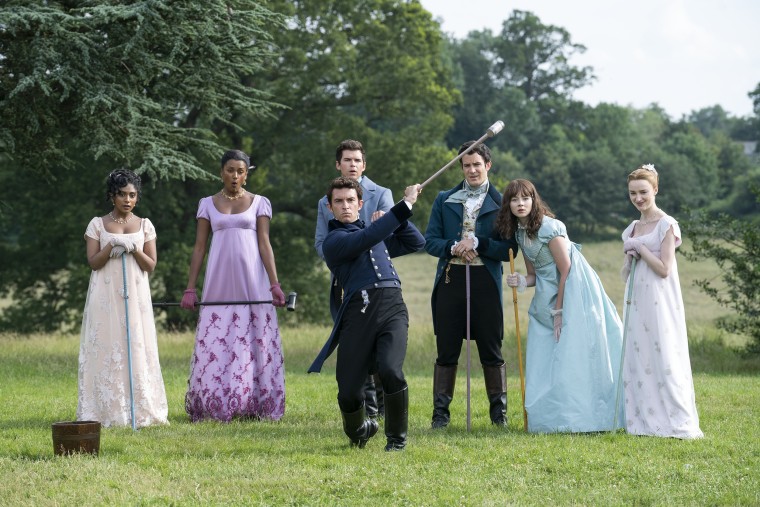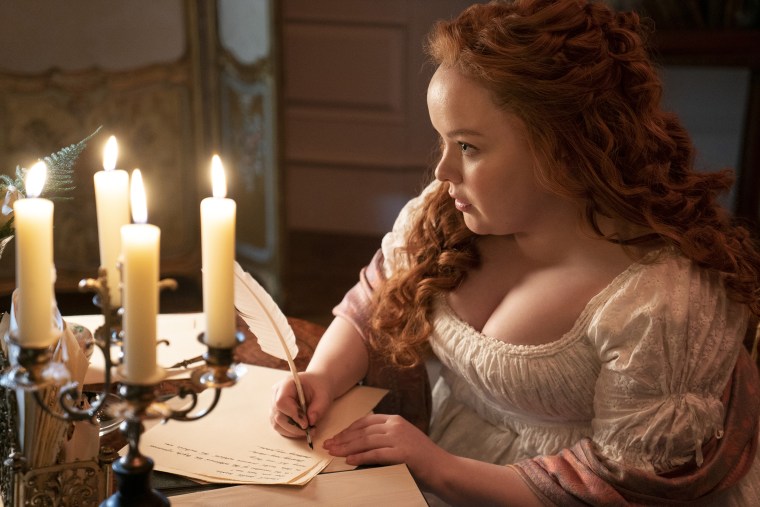"Bridgerton" names fit right in with the new Netflix series’ lavish costumes, sparkling dialogue, and beautiful people walking down beautiful vistas (with nary a horse dropping in sight).
Based on the romantic historical novels by Julia Quinn, the series revolves around the Bridgerton family who live in London in 1813. Most charmingly, the eight Bridgerton children are named alphabetically in order of age: Anthony, Benedict, Colin, heroine Daphne, Eloise, Francesca, Gregory, and Hyacinth.
Related: 'Bridgerton' season two is coming. Here's everything we know
Are these 19th century names used in "Bridgerton" part of the series’ enthralling fantasy or do they represent historical reality? Which Bridgerton names would you be likely to encounter if you visited the real 1813 London, and which most decidedly belong in fiction?
According to my research, the names fall into three groups.
Realistic 19th Century Names
These are the "Bridgerton" names that you would be most likely to encounter in early 19th century London, according to statistics. Girl names from the 1800s and common boy names from the 1800s include:
Anthony — The eldest Bridgerton child, and the first to start the alphabet pattern in the family. In 1800, Anthony ranked #33 in England and Wales. The traditional English pronunciation to pronounce the "th" as a hard T as with Thomas.
Charlotte — Queen Charlotte is based on the real queen consort in 1813: Charlotte of Mecklenburg-Strelitz. Her husband King George also features in the series and they even mention their daughter Princess Amelia who was known to the family as “Emily.” Charlotte also had at least two nephews named Friedrich, though both died in childhood.
Genevieve — Genevieve is the French modiste who is privy to most of the gossip of the Ton. It was a well-used name in France in the 18th century thanks to its being borne by the patron saint of Paris and even 17th century French royalty.
Gregory — The youngest Bridgerton son is Gregory. The name had been in the top 50 in England in the 16th century but had gradually seen a decline. By 1813, the name was moderately used and sat just below the top 200 throughout the 19th century.
Henry — Sir Henry Granville is a friend of Benedict Bridgerton. Henry was #8 in 1800 and remained popular through the 19th century.
Kitty / Lucy — Both Kitty and Lucy are married ladies of The Ton. Familiar as Jane Austen characters also, Catherine was #14, Kitty alone was #36 and Lucy was #22 in England and Wales in 1800.
Marina — Marina Thompson is a cousin of the Featheringtons who causes a stir when she comes to stay for the season. Marina was in small to moderate use in the late 18th century with 352 women with the name on the 1841 census. Appropriately for a sea-themed name, it was most common in coastal Cornwall and Devon.
Philippa / Prudence / Penelope — The Featherington daughters all share their mother Portia’s P initial. Queenly Philippa had for centuries been just the Latinized form — believe it or not, girls in England used to answer simply to “Philip” — but it had come into its own in the 18th century and it was moderately used throughout the 19th century. Slightly more common was Penelope, borne by the faithful wife of Odysseus who waited decades for his return, which was also in moderate use. The most common of the three was Prudence, which ranked just below the top 100 in the early 19th century.
Rose — Borne by Daphne Bridgerton’s lady’s maid, Rose was a top 50 name in England from the 14th to the 18th century and ranked at #65 by 1840.
Simon — The romantic hero of Series One is Simon Basset, Duke of Hastings. Simon ranked at #35 in 1800.
Violet — The matriarch of the Bridgerton family is Violet whose name had been in used as an, albeit rare, given name since the Middle Ages. By the 18th century, it was uncommon in England (ranking below the top 200), but it was more common in Scotland. Of the 809 Violets recorded on the 1841 census, 70% were living in Scotland compared with 30% living in England.
Will(iam) / Alice — Will Mondrich is a boxer and friend of the Duke. He and his wife Alice have perfectly popular names for their age. William was #1 and Alice was #19 in 1800 in England and Wales. Will even fights an opponent named Billy (presumably also a William) in one episode, which rings true given how common the name was.

Rare 19th Century Names
These "Bridgerton" names were rare in 1813 London, though they did exist.
Albion / Nigel — Albion Finch and Nigel Berbrooke are members of the Ton. Both names were in use at the end of the 18th century but can only be found in a handful of records.
Benedict — The name of the second Bridgerton son. Although this saintly name had been in regular use in the Middle Ages, by the late 18th century, you could count on one hand the number of boys Christened with the name each year.
Colin — Colin is the third Bridgerton son, but his name is somewhat strange choice for the name of an English gentleman in 1813. You see, the English name Colin (a medieval form of Nicholas) had by the 16th century become the familiar name for a country laborer and was commonly used as such in pastoral verse. This led to a general decline in the name in England. The Scottish Colin (from the Gaelic Cuilan), however, was in good use at this time.
Cressida / Portia — Thanks to Shakespeare’s heroines, Cressida and Portia were by no means unknown in 1813. Cressida was, however, extremely rare. There are only two on the 1841 census and previously there were only a handful of baptisms throughout the whole of the 18th century (the century the character would have been born in). Portia was only slightly more common with 26 women on the 1841 census.
Daphne — As a classical name which was borne by a tragic romantic heroine in Greek mythology, Daphne seems like a perfect choice for the eldest Bridgerton daughter. Daphne was incredibly rare from 1750 to 1850 with only a tiny handful of baptisms and only came into regular use at the end of the 19th century.
Eloise — The second Bridgerton daughter is Eloise. Her medieval name — which was also linked to a tragic romance — was marginally more common than Daphne, but it was still quite a unique choice for the time.

Fantasy "Bridgerton" Names
These names are part of the frothy "Bridgerton" fantasy world: It would be extremely unlikely to encounter anyone with these names in early 19th century Britain.
Francesca — The sixth Bridgerton child is Francesca, the Italian from of Frances in use in Italy from at least the 13th century. Fittingly, like Daphne and Eloise, Francesca was also associated with a tragic love affair. In England, Francesca appears several times in English baptisms in the 18th century, but in almost every case it is used in Latinized records: these girls, in fact, would have all answered to “Frances.” The tiny number of true Francescas on the 1841 census were all born to Italian parents.
Hyacinth — The youngest Bridgerton daughter is Hyacinth. Although it can be found in use France and Germany in 1813, Hyacinth was extremely rare in Britain. Moreover, wherever it was used, Hyacinth was (during this period at least) a masculine name, thanks to its being a modern form of the Ancient Greek Hyacinthus, which was not only a character in mythology, but also borne by several early male saints.
Siena — This beautiful Italian city is given to an opera singer in the series. It was used on the Continent in small numbers in the 18th century (especially in the Netherlands and Germany) in reference to St. Catherine of Siena (often Siena was a middle name after Catherine). It was extremely rare in Britain and the earliest records that can be found date from the 19th century — not the 18th. In the novels, she is named Maria — a far more likely choice.
Top 50 rankings for 1800 are taken from Leslie Dunkling’s The Guinness Book of Names. Rankings for 1840 and beyond are from my own data research (full lists at britishbabynames.com). Other records such as 1841 UK census and baptism records pre-1815 are taken from ancestry.co.uk, findmypast.co.uk and familysearch.org.
This story originally appeared on Nameberry.com.